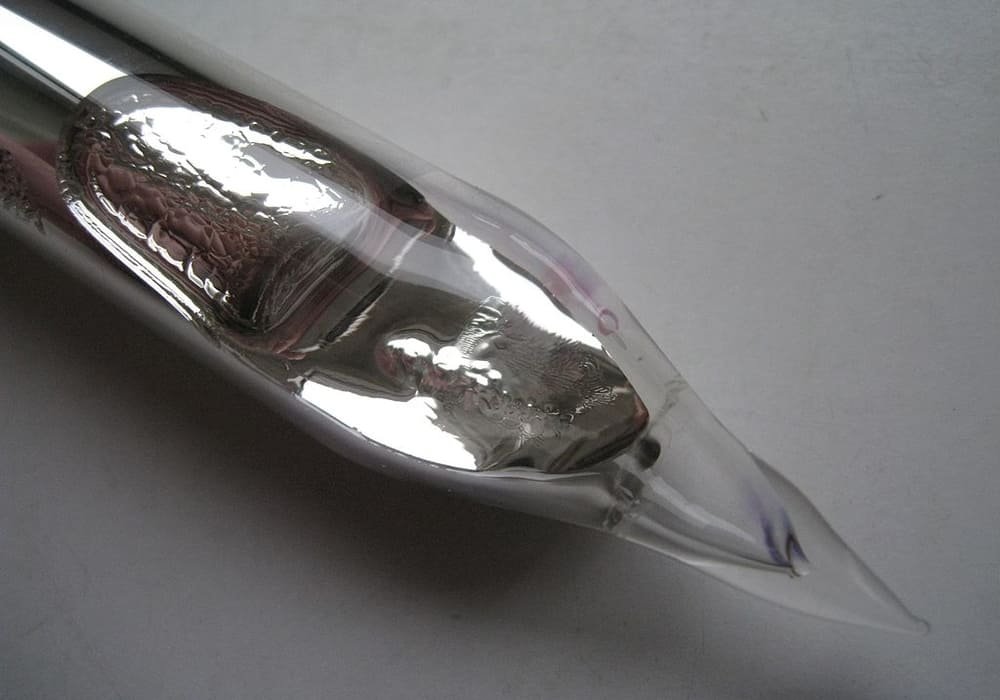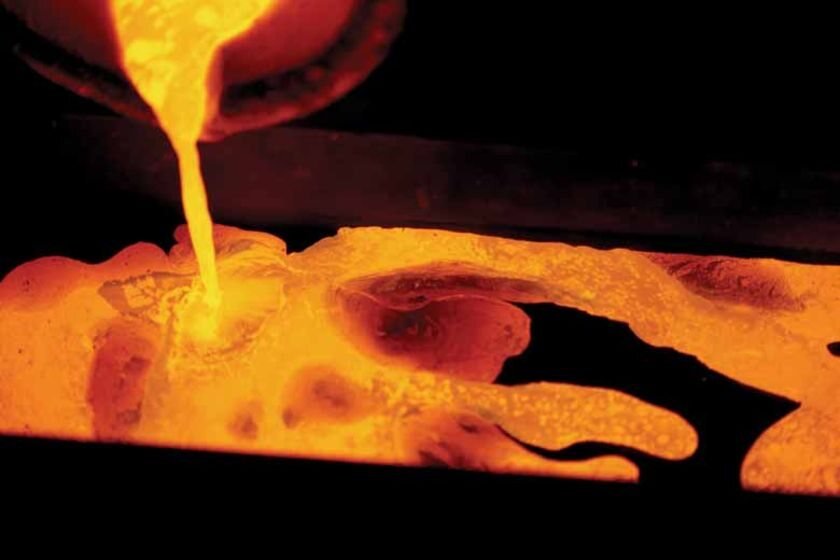Rubidium is the chemical element with atomic number 37, symbol Rb
Rubidium is an alkali metal, soft and silvery, with a melting point of only 39.3 °C (102.74 °F). It can be kept liquid at room temperature thanks to the phenomenon of supercooling, like cesium and gallium.
Its name comes from the Latin rubidus (dark red), due to the red color of the spectral lines which allowed Robert Wilhelm Bunsen and Gustav Kirchhoff to detect it in 1861 in lepidolite. He was isolated the following year by Bunsen.
Like other alkali metals, it ignites spontaneously on contact with air and reacts violently with water.
Uses of Rubidium
Photovoltaic cells: it is used as an alloy with cesium.
Tempered safety glass: the addition of rubidium carbonate (Rb2CO3) or rubidium oxide (Rb2O) makes it possible to obtain safety glass by tempering.
Demonstration of laser cooling , since cheap laser diodes are available for the relevant wavelengths (thus comparatively easy production of a Bose-Einstein condensate).
In fireworks to create purple fire.
Medicine:
Examination of myocardial perfusion in nuclear medicine: due to its similarity to potassium, the positron-emitting radioactive isotope 82Rb, with a short half-life (75 seconds), is used as an indicator of ischemia in PET (Positron emission tomography) and use as an 81 m krypton generator in lung scintigraphy (Rb81).
Manufacture of certain nooanaleptic drugs.
Atomic Physics: The rubidium atom (both its 85 and 87 isotopes) is very frequently used for atomic physics experiments. Indeed, certain transitions of this atom correspond to conventional laser wavelengths (780 nm for the 5s-5p transition in particular), which facilitates the experiments. Among others, rubidium can be used for the construction of atomic clocks using the hyperfine transition from 87Rb to 6.834 682 611 GHz.
Physiology
Rubidium is probably not essential for plants; in animals it seems to be necessary for normal pregnancy . The rubidium requirement of humans is likely to be less than 100 µg per day. With the usual mixed diet, it comes to around 1.7 mg per day. A rubidium deficiency is just as unlikely with this offer as a nutritive rubidium contamination.
Tea and coffee – Arabica coffee has the highest rubidium content found in food (Arabica bean: 25.5–182 mg / kg dry matter) – adults provide an average of 40% of the amount of rubidium consumed. Rubidium acts in the central nervous system and influences the concentration of neurotransmitters there, the use of rubidium as an antidepressant agent is being discussed. A rubidium deficiency can bepresentin dialysis patients
Safety instructions
Rubidium reacts violently with water and can ignite the hydrogen given off in the reaction:
- 2 Rb + 2 H 2 O → 2 Rb (OH) + H 2
It is self-igniting and reacts extremely violently with water. For safety reasons, rubidium should be stored in dry mineral oil , in a vacuum or in an inert gas atmosphere.
Health effects of rubidium
Rubidium is moderately toxic if swallowed. Ignited, it can cause thermal burns. Its reaction with moisture forms a hydroxide which can chemically burn the skin.
Rubidium in the periodic table
| Atomic number (Z) | 37 |
|---|---|
| Group | group 1: H and alkali metals |
| Period | period 5 |
| Block | s-block |
| Electron configuration | [Kr] 5s1 |
| Electrons per shell | 2, 8, 18, 8, 1 |
Vapor pressure
| P (Pa) | 1 | 10 | 100 | 1 k | 10 k | 100 k |
|---|---|---|---|---|---|---|
| at T (K) | 434 | 486 | 552 | 641 | 769 | 958 |
Physical properties
| Physical properties | |
|---|---|
| Phase at STP | solid |
| Melting point | 312.45 K (39.30 °C, 102.74 °F) |
| Boiling point | 961 K (688 °C, 1270 °F) |
| Density (near r.t.) | 1.532 g/cm3 |
| when liquid (at m.p.) | 1.46 g/cm3 |
| Triple point | 312.41 K, ? kPa |
| Critical point | 2093 K, 16 MPa (extrapolated) |
| Heat of fusion | 2.19 kJ/mol |
| Heat of vaporization | 69 kJ/mol |
| Molar heat capacity | 31.060 J/(mol·K) |
Atomic properties
| Atomic properties | |
|---|---|
| Oxidation states | −1, +1 (a strongly basic oxide) |
| Electronegativity | Pauling scale: 0.82 |
| Ionization energies |
|
| Atomic radius | empirical: 248 pm |
| Covalent radius | 220±9 pm |
| Van der Waals radius | 303 pm |
Other properties
| Other properties | |
|---|---|
| Natural occurrence | primordial |
| Crystal structure | body-centered cubic (bcc) |
| Speed of sound thin rod | 1300 m/s (at 20 °C) |
| Thermal expansion | 90 µm/(m·K) (at r.t.) |
| Thermal conductivity | 58.2 W/(m·K) |
| Electrical resistivity | 128 nΩ·m (at 20 °C) |
| Magnetic ordering | paramagnetic |
| Magnetic susceptibility | +17.0·10−6 cm3/mol (303 K) |
| Young’s modulus | 2.4 GPa |
| Bulk modulus | 2.5 GPa |
| Mohs hardness | 0.3 |
| Brinell hardness | 0.216 MPa |
| CAS Number | 7440-17-7 |
History
| History | |
|---|---|
| Discovery | Robert Bunsen and Gustav Kirchhoff (1861) |
| First isolation | George de Hevesy |
Isotopes of rubidium
It has 32 known isotopes, with mass numbers varying between 71 and 102, and 12 nuclear isomers. Only two of these isotopes are present in nature, 85Rb (72.2%), the only stable isotope of rubidium (making it a monoisotopic element) and the radioactive 87Rb (27.8%). The natural rubidium is thus sufficiently radioactive to impress a photographic film in thirty to sixty days. Rubidium is assigned a standard atomic mass of 85.4678 (3) u.
| Main isotopes of rubidium | |||||||||||||||||||||||||||||||||||||||||
|---|---|---|---|---|---|---|---|---|---|---|---|---|---|---|---|---|---|---|---|---|---|---|---|---|---|---|---|---|---|---|---|---|---|---|---|---|---|---|---|---|---|
| |||||||||||||||||||||||||||||||||||||||||
Periodic Table of Elements | Complete List of Chemical Elements by Group, Name, Symbol, Color and Type

Sources: Live Science,
Photo credit: Wikimedia Commons
Photo explanations: rubidium metal sample from the Dennis s.k collection. If you look close you can see some colorful superoxide inside the ampoule. These are only visible in bright light.


